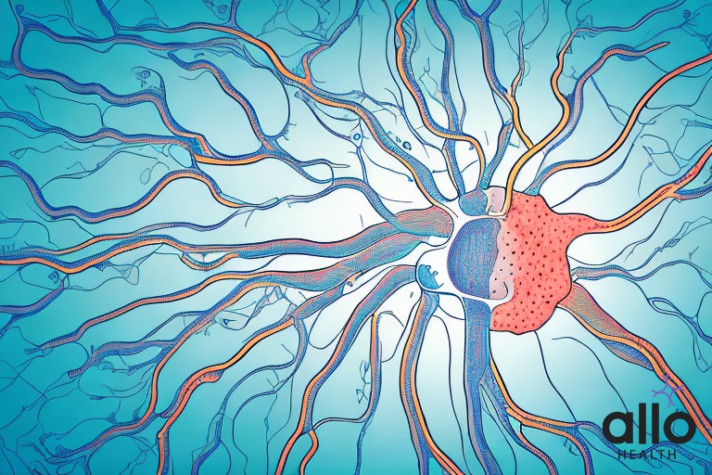Understanding Ejaculating Urine: Causes and Treatment Options

Allo Health is dedicated to personalized well-being, offering support and trusted information tailored to individual health goals. The platform emphasizes human-generated content, led by a distinguished medical team of experts, including physicians and sexual health specialists. Their commitment to credibility involves rigorous fact-checking, authoritative research, and continuous updates to ensure accurate, up-to-date information. Allo Health's unique approach goes beyond conventional platforms, providing expert-led insights and a continuous commitment to excellence, with user feedback playing a crucial role in shaping the platform's authoritative voice.

Dr Sanina Mansoor holds MBBS degree from Yenepoya university,Mangalore.She has 8 years of experience working as a medical officer at various health centres and medical colleges.
Why This Was Upated?
Our experts continually monitor the health and wellness space, and we update our articles when new information became available.
Updated on 21 June, 2024
- Article was updated as part of our commitment to diversity, equity, and inclusion.

"The following blog article provides general information and insights on various topics. However, it is important to note that the information presented is not intended as professional advice in any specific field or area. The content of this blog is for general educational and informational purposes only.
Book consultation
The content should not be interpreted as endorsement, recommendation, or guarantee of any product, service, or information mentioned. Readers are solely responsible for the decisions and actions they take based on the information provided in this blog. It is essential to exercise individual judgment, critical thinking, and personal responsibility when applying or implementing any information or suggestions discussed in the blog."
Ejaculating urine, also known as post-micturition dribble, refers to the involuntary release of urine after a person has finished urinating. Although it can affect both men and women, it is more common in men and can be a source of significant embarrassment and distress. In this article, we will explore the causes and treatment options for ejaculating urine, as well as tips for managing daily life with this condition.
Ejaculating Urine Causes & Symptoms
“Ejaculating urine,” also known as urinary incontinence during ejaculation, is a relatively uncommon condition where urine is expelled during sexual climax. This phenomenon may be referred to as coital incontinence or orgasmic incontinence. It’s important to note that this is not a normal or typical occurrence, and individuals experiencing such symptoms should seek medical attention for a thorough evaluation. Here are some possible causes and symptoms associated with ejaculating urine:
Causes:
- Prostate Concerns:
- Prostatitis: Inflammation of the prostate gland can cause irritation and affect the normal functioning of the urethra, leading to urine leakage during ejaculation.
- Enlarged Prostate (BPH): Benign prostatic hyperplasia can cause compression of the urethra, leading to difficulty controlling urine during ejaculation.
- Urethral Disorders:
- Urethral diverticulum: A pouch-like sac that forms in the urethra may lead to urinary leakage during sexual activity.
- Urethral stricture: Narrowing of the urethra can cause difficulty with urine flow, and this may result in incontinence during ejaculation.
- Neurological Concerns:
- Spinal cord injuries or diseases: Conditions affecting the nerves that control bladder function can lead to urinary incontinence during ejaculation.
- Multiple sclerosis (MS): Neurological disorders like MS can impact nerve signals and result in loss of bladder control.
- Bladder Dysfunction:
- Overactive bladder: A condition where the bladder contracts involuntarily, causing urgency and, in some cases, leakage during sexual activity.
Symptoms:
- Urinary Leakage:
- Involuntary release of urine during sexual climax or orgasm.
- The amount of leakage can vary from a few drops to a more significant amount.
- Discomfort or Pain: Pain or discomfort during urination or ejaculation.
- Frequency and Urgency:
- Frequent urges to urinate, even when the bladder is not full.
- A sense of urgency to urinate that may be difficult to control.
- Other Associated Symptoms: Symptoms associated with the underlying cause, such as pain in the pelvic region, lower back pain, or changes in urinary habits.
Ejaculating Urine Diagnosis
Diagnosing the cause of ejaculating urine, or urinary incontinence during ejaculation, involves a thorough medical evaluation by a healthcare professional. The diagnostic process may include the following steps:
Medical History:
- The healthcare provider will begin by taking a detailed medical history, including information about the onset, duration, and frequency of symptoms.
- Questions may be asked about urinary habits, any associated pain or discomfort, and other relevant medical conditions.
Physical Examination:
- A physical examination is conducted to assess the pelvic region, including the prostate (in men), the urinary tract, and the nervous system.
- The healthcare provider may perform a digital rectal examination (DRE) to assess the prostate gland.
Urodynamic Testing:
- Urodynamic tests evaluate the function of the bladder, sphincters, and urethra. These tests help determine how well the urinary system is storing and releasing urine. Examples include:
- Cystometry: Measures bladder pressure during filling.
- Pressure-flow studies: Evaluate the flow of urine during voiding.
- Urethral pressure profile: Assesses the pressure along the length of the urethra.
Imaging Studies:
- Various imaging studies may be employed to visualize the urinary tract and identify any structural abnormalities:
- Ultrasound: Provides images of the bladder, prostate, and surrounding structures.
- Cystoscopy: Involves inserting a thin tube with a camera (cystoscope) into the urethra and bladder for direct visualization.
Laboratory Tests:
- Urinalysis may be performed to check for signs of infection, blood, or other abnormalities in the urine.
- Blood tests may be ordered to assess kidney function and screen for systemic conditions.
Neurological Evaluation:
- If neurological concerns are suspected, additional assessments may be necessary:
- Neurological examination: Evaluates reflexes, sensation, and muscle strength.
- Imaging studies: MRI or CT scans may be conducted to assess the spinal cord and brain.
Specialized Tests:
- In some cases, specialized tests may be conducted based on the suspected underlying cause:
- Prostate-specific antigen (PSA) test: Measures PSA levels in the blood to assess prostate health.
- Urethral pressure profilometry: Measures pressure along the length of the urethra during various activities.
Patient Diary:
- Keeping a voiding diary can help track daily fluid intake, voiding frequency, and episodes of incontinence. This information aids in understanding patterns and triggers.
Psychosocial Assessment:
- Understanding the impact of symptoms on a person’s quality of life and mental well-being is essential. A psychosocial assessment may be conducted.
Collaboration with Specialists:
- Collaboration with urologists, neurologists, or other specialists may be necessary, depending on the findings and suspected causes.
Treatment Planning:
- Once a diagnosis is established, the healthcare provider can develop an individualized treatment plan. Treatment may involve addressing the underlying cause, such as managing prostate concerns, treating infections, or addressing neurological conditions.
It’s important to note that diagnosing ejaculating urine requires a comprehensive approach, and the specific tests conducted will depend on the individual’s symptoms, medical history, and physical examination findings. If you are experiencing such symptoms, it is crucial to seek prompt medical attention for a thorough evaluation and appropriate management.

Ejaculating Urine Treatment
The treatment of ejaculating urine, or urinary incontinence during ejaculation, depends on the underlying cause identified through a thorough diagnostic evaluation. Treatment approaches may vary, and a healthcare professional will develop an individualized plan based on the specific diagnosis and the patient’s overall health. Here are some possible treatments based on common underlying causes:
Prostate Concerns:
- Prostatitis Treatment:
- Antibiotics may be prescribed to treat bacterial infections in the prostate.
- Anti-inflammatory medications may help reduce inflammation.
- Enlarged Prostate (BPH) Treatment:
- Alpha-blockers or 5-alpha reductase inhibitors may be prescribed to manage symptoms associated with an enlarged prostate.
- In some cases, surgical procedures such as transurethral resection of the prostate (TURP) or laser surgery may be recommended.
Urethral Disorders:
- Urethral Diverticulum Treatment: Surgical removal of the diverticulum may be necessary.
- Urethral Stricture Treatment: Dilation or urethroplasty procedures may be performed to widen or reconstruct the narrowed urethra.
Neurological Concerns:
- Management of Spinal Cord Injuries or Diseases:
- Physical therapy and rehabilitation to improve muscle function and coordination.
- Medications to manage spasticity or other neurological symptoms.
- Management of Multiple Sclerosis (MS):
- Disease-modifying therapies to slow the progression of MS.
- Symptomatic treatment to manage specific symptoms, such as bladder dysfunction.
Bladder Dysfunction:
- Overactive Bladder Treatment:
- Medications, such as anticholinergics or beta-3 agonists, to relax the bladder and reduce urgency.
- Behavioral therapies, including pelvic floor exercises and bladder training.
Behavioral and Lifestyle Modifications:
- Pelvic Floor Exercises (Kegel exercises): Strengthening the pelvic floor muscles may help improve bladder control.
- Bladder Training: Gradual scheduling of bathroom visits to train the bladder to hold urine for longer periods.
- Fluid Management: Adjusting fluid intake, especially before sexual activity, to minimize the risk of incontinence.
Medications:
- Depending on the underlying cause, medications may be prescribed to manage specific symptoms or conditions.
Surgical Interventions:
- In some cases, surgical procedures may be necessary to address structural concerns or correct anatomical abnormalities.
Counseling and Support:
- Psychosocial support may be beneficial, especially if urinary incontinence has a significant impact on the individual’s emotional well-being and relationships.
Follow-up Care:
- Regular follow-up with healthcare providers to monitor progress and adjust treatment plans as needed.
It’s essential for individuals experiencing ejaculating urine to communicate openly with their healthcare providers about symptoms, concerns, and the impact on their quality of life. This will help in determining the most appropriate and effective treatment options tailored to their specific situation. Treatment success often depends on the collaboration between the patient and the healthcare team.
Ejaculating Urine Prevention
Preventing ejaculating urine, or urinary incontinence during ejaculation, involves addressing the underlying causes and implementing lifestyle modifications. While it’s crucial to note that prevention strategies may vary depending on the specific cause, here are general recommendations that may help reduce the risk or severity of ejaculating urine:
Maintain Prostate Health:
- Regular Prostate Exams: For individuals with a prostate, regular check-ups and prostate exams can help identify and address concerns early on.
Promote Urinary Tract Health:
- Stay Hydrated: Drink an adequate amount of water daily to maintain urinary tract health. However, moderation is key, and excessive fluid intake before sexual activity may increase the risk of incontinence.
- Practice Good Hygiene: Maintain good genital hygiene to prevent urinary tract infections.
Pelvic Floor Exercises:
- Kegel Exercises: Strengthening the pelvic floor muscles through Kegel exercises may help improve bladder control. These exercises can be done regularly to enhance muscle tone.
Maintain Overall Health:
- Regular Exercise: Engage in regular physical activity to support overall health, including the health of the urinary and reproductive systems.
- Maintain a Healthy Weight: Excess weight can contribute to pressure on the pelvic floor and exacerbate urinary concerns. Maintaining a healthy weight through a balanced diet and regular exercise may be beneficial.
Manage Chronic Conditions:
- Control Diabetes: For individuals with diabetes, maintaining blood sugar levels within a healthy range is important to prevent complications, including urinary concerns.
- Manage Neurological Conditions: If you have a neurological condition, work closely with your healthcare team to manage symptoms and prevent complications.
Avoid Irritants:
- Limit Caffeine and Alcohol: Both caffeine and alcohol can irritate the bladder, potentially worsening urinary symptoms.
- Quit Smoking: Smoking can contribute to bladder irritation and is associated with various health concerns. Quitting smoking may have positive effects on overall urological health.
Behavioral Strategies:
- Bladder Training: Practice bladder training to gradually extend the time between bathroom visits, promoting better bladder control.
- Fluid Management: Adjust fluid intake, especially before sexual activity, to reduce the likelihood of urinary incontinence during ejaculation.
Regular Check-ups:
- Routine Medical Check-ups: Regular visits to healthcare providers allow for the early detection and management of potential concerns that could contribute to ejaculating urine.
Open Communication:
- Discuss Symptoms with Healthcare Providers: If you experience any changes in urinary function or incontinence during ejaculation, communicate openly with healthcare providers to ensure prompt evaluation and appropriate management.
It’s important to recognize that prevention strategies may not completely eliminate the risk of ejaculating urine, especially if there are underlying medical conditions. Therefore, seeking timely medical advice and addressing any emerging symptoms are crucial components of preventive care. Individualized guidance from healthcare professionals is essential for those concerned about urinary incontinence during ejaculation.
Most Asked Questions
-
What Causes Ejaculating Urine?
Ejaculating urine, or urinary incontinence at some stage in ejaculation, can be caused by various factors. Prostate concerns, which include prostatitis or an enlarged prostate (BPH), urethral disorders like diverticulum or stricture, neurological situations (e.G., spinal wire accidents or multiple sclerosis), and bladder dysfunction (together with overactive bladder) are commonplace contributors. Determining the unique reason is essential for powerful treatment.
-
How is Ejaculating Urine Diagnosed?
Diagnosis entails a thorough scientific history, bodily examination, and specialized tests. Urodynamic testing assesses bladder feature, whilst imaging studies like ultrasound and cystoscopy visualize the urinary tract. Neurological reviews can be conducted for suspected nerve-associated troubles. Laboratory checks, which include urinalysis, assist become aware of infections or abnormalities. Collaborative efforts with urologists and other professionals may be essential.
-
What Treatments are Available for Ejaculating Urine?
Treatment varies primarily based on the underlying reason. For prostate concerns, antibiotics or surgical approaches may be recommended. Urethral disorders may require surgical removal or reconstruction. Neurological concerns can be managed with medicines or rehabilitation. Overactive bladder can be addressed with medicines or behavioral healing procedures. Behavioral changes, medications, and, in some cases, surgical procedure can be hired, emphasizing the significance of an individualized method.
-
Can Ejaculating Urine be Prevented?
Prevention entails preserving usual fitness, promoting urinary tract fitness, and managing continual conditions. Pelvic floor physical games, regular exercising, and a healthy weight make contributions to bladder health. Avoiding irritants like caffeine and alcohol, practicing bladder schooling, and communicating overtly with healthcare vendors are critical preventive techniques.
-
When Should I Seek Medical Help for Ejaculating Urine?
Seek scientific attention if you revel in urinary incontinence throughout ejaculation. Early prognosis and treatment can save you headaches. Contact a healthcare provider in case you be aware adjustments in urinary habits, pain or pain, or if symptoms effect your best of lifestyles. Timely intervention is critical for powerful management and advanced urological health.






































